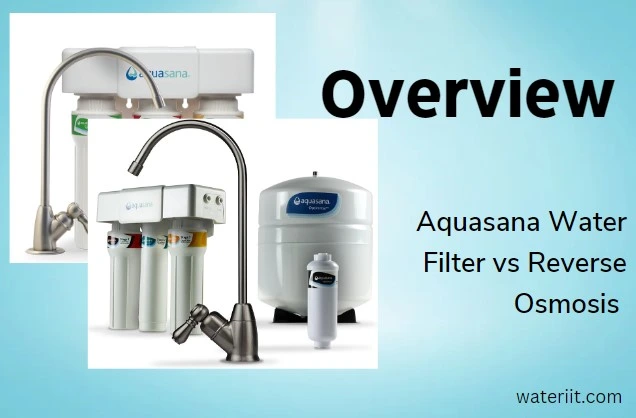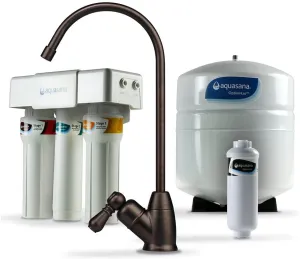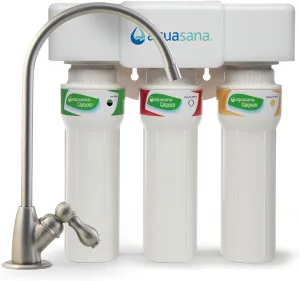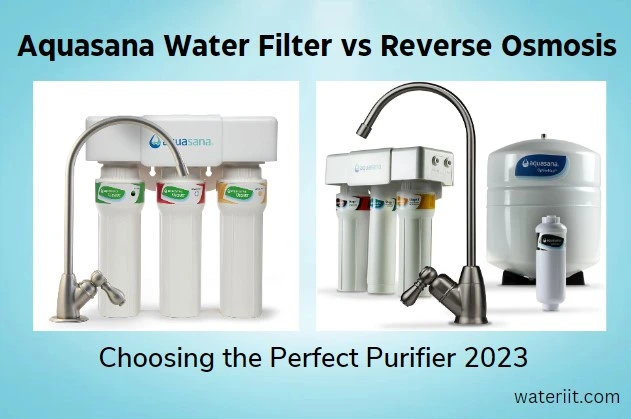Both reverse osmosis and carbon filters are feasible options for water purification. If you’re unsure which choice is best, we’re here to help you compare Aquasana water filters and reverse osmosis.
Each water filter available for purchase has distinct strengths and disadvantages that set it apart from the competition.
Our goal is to provide you with thorough information on various water filter types, allowing you to make an informed decision about the best option for your household.
We attempt to present you with the best solutions available of Aquasana water filters and reverse osmosis.
- Comparison Table: Aquasana Water Filter vs Reverse Osmosis
- Overview: Aquasana Water Filter vs Reverse Osmosis
- What Is Reverse Osmosis and How Does It Work?
- Why Choose Reverse Osmosis Water Filters?
- Functionality of Carbon Filters: Aquasana Water Filter vs Reverse Osmosis
- Comparison: Aquasana water filter vs Reverse Osmosis
- Choosing the Right System: Aquasana water filter vs Reverse Osmosis
- Conclusion
- FAQs
Comparison Table: Aquasana Water Filter vs Reverse Osmosis
WATER FILTER | FEATURES | REVERSE OSMOSIS |
Aquasana 3-Stage Max Flow Claryum Under Sink Water Filter System
| Image | Aquasana Reverse Osmosis Under Sink Water Filter System
|
Carbon filter | Filtration system | Reverse osmosis membrane |
Bronze, Nickel, Chrome | Faucets | Bronze, Nickel, Chrome |
Heavy metallurgy, cysts, asbestos | Contaminants Removal | Lead, asbestos, chlorine, arsenic, fluoride |
Little to no maintenance | Maintenance | Needs regular maintenance |
Buy Button | Price | Buy Button |
High | Flow Rate | Moderate |
Low | Water Waste | Moderate to high |
Under sink | Installation | Under sink |
Varies | Filter Lifespan | Typically, 6-12 months for RO membrane, 3-6 months for other filters |
Provides some level of water softening | Additional Treatment | Does not provide water softening |
Retains essential minerals | Mineral Retention | Removes minerals from water |
Compact | System Size | Requires more space |
Moderate | Filter Replacement Cost | Moderate to high |
Varies | Filter Indicator | Typically includes filter replacement indicator |
Price |
Overview: Aquasana Water Filter vs Reverse Osmosis

Aquasana Water Filter and Reverse Osmosis (RO) systems are popular ways to obtain clean and purified water. While both seek to produce high-quality drinking water, their filtering processes and features differ. Let’s look at the essential features of each system to better grasp their parallels, distinctions, and benefits.
Aquasana Water Filter
To eliminate impurities from tap water, the Aquasana Water Filter employs a multi-stage filtration process.
It used activated carbon filters, which are effective at adsorbing pollutants and improving the flavour of water.
Aquasana filters successfully remove chlorine, heavy metals, cysts, asbestos, and other common pollutants from drinking water, ensuring clean and safe drinking water.
Key Features of Aquasana Water Filter
Filtration System:
The Aquasana Water Filter uses activated carbon filters to effectively remove pollutants from the water.
Faucets:
Available in a variety of styles, including Bronze, Nickel, and Chrome, allowing you to match your kitchen’s décor.
Contaminants Removal:
Aquasana filters are meant to remove contaminants, including chlorine, heavy metals, cysts, asbestos, and others.
Maintenance:
Because these filters require little to no maintenance, they are user-friendly.
Pricing:
Aquasana Water Filters come in a variety of pricing ranges, allowing you to select one that fits your budget.
Reverse Osmosis
Reverse osmosis is a highly effective water purification method that removes pollutants from water using a semipermeable membrane.
It is well-known for its capacity to remove particles as fine as 0.1 microns in size, such as lead, asbestos, chlorine, and other pollutants.
RO systems deliver pure water, making them popular among people seeking the highest level of filtration.
Key Features of Reverse Osmosis
Filtration System:
Filtration systems use a semipermeable membrane to selectively enable pure water molecules to pass through while inhibiting solid impurities.
Removal of Contaminants:
Reverse Osmosis is extremely effective at eliminating a wide range of pollutants, including lead, asbestos, chlorine, and different chemicals.
Wastewater Generation:
RO systems generate a substantial amount of wastewater, with a typical wastewater-to-water ratio of 4:1. This means that four gallons of waste are produced for every gallon of pure water produced.
Mineral Removal:
One disadvantage of RO systems is that they can remove vital minerals from water, altering its flavor and nutritional value.
Maintenance:
To guarantee optimal performance, reverse osmosis systems require regular maintenance, including filter replacement.
What Is Reverse Osmosis and How Does It Work?
Reverse Osmosis is an amazing filtration technology that uses a semipermeable membrane to selectively enable clean water molecules to pass through while inhibiting solid impurities.
It means that everything larger than a water molecule is efficiently eliminated, including typical pollutants such as lead, asbestos, chlorine, and different chemicals.
Why Choose Reverse Osmosis Water Filters?
PROS | CONS |
Exceptional ability to remove impurities as small as 0.1 microns. | Substantial amount of wastewater generated (wastewater-to-water ratio of 4:1). |
Preferred by chefs for providing the purest water for cooking. | Increased strain on the RO system due to electricity usage and wastewater recycling, requiring more frequent filter replacements. |
Functionality of Carbon Filters: Aquasana Water Filter vs Reverse Osmosis
In this part of Aquasana water filters to reverse osmosis, we will look at how carbon filters operate.
Most water filtration systems employ carbon filters to prevent impurities from entering your tap or showerhead.
Adsorption occurs as a result of the attractive interactions between molecules and the surface area of the filter.
This adsorption process enables carbon filters to effectively absorb poisons from water that has been in prolonged contact with the carbon medium.
Types of Carbon Filters
Carbon filters are classified into two types: activated carbon and pre-activated carbon.
Because coal or wood-activated carbon media is more efficient than other types of activated carbon media, it is used in most water filters.
The porosity of these filters is extraordinary, with a small amount having more surface area than an entire football pitch. Because of their large surface area, they may effectively remove pollutants by adsorption.
Special Consideration for Chlorine and Chloramines Removal
Catalytic carbon is the best alternative for removing chlorine and chloramines from water. It can stimulate chemical reactions and has several advantages over activated carbon.
By using catalytic carbon, tap water can be efficiently treated to eliminate chlorine and chloramines.
Benefits of Using Carbon Filters
The elimination of chlorine is successful when paired with a carbon filter, resulting in better-tasting and safer drinking water.
Furthermore, carbon filters function passively, consuming no water or electricity as water passes through them, resulting in cost savings, these filters need little maintenance, usually requiring an occasional filter change every few months, making them desirable to consumers.
Comparison: Aquasana water filter vs Reverse Osmosis
Aquasana OptimH2O Reverse Osmosis System

- Package components: Includes filters and membranes for reverse osmosis.
- Faucets: Choose from stylish options like brushed nickel, chrome, or oil-rubbed bronze.
- Tubing and fittings: Comes with everything you need for easy installation.
- Functionality: Utilizes a combination of RO membrane and Claryum® filter to effectively remove pollutants.
- Long-lasting filters: The RO membrane lasts 1 year, remineralization filter lasts 1 year, and Claryum® filter lasts 6 months.
- Pros: Removes a wide range of contaminants, provides filtered and mineralized water, highly efficient removal system.
- Cons: Reduced water pressure, installation can be a bit challenging, some water wastage during the RO process.
Aquasana 3-Stage Max Flow Under Counter Water Filter

- Three-piece filter set: Included filters for comprehensive filtration.
- Filter housing: Keeps out dust and air particles, ensuring cleaner water.
- Faucet options: Available in brushed nickel, chrome, or oil-rubbed bronze finishes.
- Tubing and fittings: Provided for convenient installation.
- Functionality: Features Claryum activated carbon and catalytic carbon media for effective filtration.
- Filter lifespan: Each filter lasts approximately 6 months.
- Pros: Easy setup, provides a good flow of water, certified chlorine and lead removal.
- Cons: Filter has a relatively short useful life, faucet design could be improved.
And the winner is...
The OptimH2O Reverse Osmosis System from Aquasana! It is the best at removing a wide range of pollutants, including potentially hazardous microbes.
It also thoroughly purifies your water using a smart combination of reverse osmosis membrane and Claryum® filter. You can also select a trendy tap to accent your kitchen decor.
Keep in mind that it may result in somewhat lower water pressure, but the benefits of clean, mineralized water outweigh the drawbacks.
Choosing the Right System: Aquasana water filter vs Reverse Osmosis
Consider your individual needs and preferences while picking between Aquasana Water Filters and Reverse Osmosis systems.
Aquasana filters provide simplicity, excellent filtration, and minimum maintenance, making them ideal for people looking for a simple solution.
Reverse Osmosis, on the other hand, gives unsurpassed purity but requires more maintenance and may eliminate beneficial minerals.
The decision is dictated by your priorities, money, and desired level of filtration. Aquasana Water Filters and Reverse Osmosis Systems may provide clean and delicious water, allowing you and your family to reap the benefits of pure hydration.
Conclusion

In summary, carbon filtering is good at eliminating chelating agents such as chlorine taste and odor, as well as capturing large particles.
However, for comprehensive purification, reverse osmosis shines by removing almost all contaminants from your water.
It is advisable to pre-filter your water to prevent membrane fouling and optimize the performance of reverse osmosis.
I trust that this comparison between the Aquasana water filter and reverse osmosis has provided you with valuable insights.
FAQs

Aquasana water filtration systems remove harmful contaminants and enhance the taste of your tap water, providing you with healthy and refreshing hydration. Choose Aquasana for clean, great-tasting water.
Aquasana offers multiple benefits:
- Whole-home safety: Ensure safe water throughout your home.
- Enhanced drinking and cooking water quality.
- Healthier hair and skin.
- Cleaner indoor air.
- Improved laundry outcomes.
Under-sink reverse osmosis (RO) systems are an excellent addition to your kitchen, delivering high-quality water for drinking, cooking, and ice making. To ensure continuous removal of dissolved solids and maintain water quality, regular maintenance is necessary for RO systems.
To maintain hygiene, either wash your hands thoroughly with soap and water or use sanitary gloves. Completely turn off the main valve. Empty all the water from your RO faucet. Take out the sediment and carbon filters from their housing. Remove the RO membrane from its housing. Place the filters outside their housings, but securely screw the housings back in place.
Also Read:
- Aquasana vs Culligan: Choosing the Best Water Filter for Your Needs
- Aquasana vs Apec 2023: Unveiling the Ultimate Water Filter Showdown – Choose Your Champion!
- Springwell vs Aquasana Water Filter 2023
- Does Reverse Osmosis Remove Chlorine And Chloramine?
- Can You Run Hot Water Through a Reverse Osmosis System?
